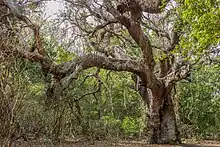Newtonia hildebrandtii
Newtonia hildebrandtii, the Lebombo wattle (Afrikaans: Lebombowattel, Zulu: Umfomothi),[1] is a medium-sized tree native to eastern Africa. It is a protected tree in South Africa.[1]
| Newtonia hildebrandtii | |
|---|---|
 | |
| Scientific classification | |
| Kingdom: | Plantae |
| Clade: | Tracheophytes |
| Clade: | Angiosperms |
| Clade: | Eudicots |
| Clade: | Rosids |
| Order: | Fabales |
| Family: | Fabaceae |
| Subfamily: | Caesalpinioideae |
| Clade: | Mimosoid clade |
| Genus: | Newtonia |
| Species: | N. hildebrandtii |
| Binomial name | |
| Newtonia hildebrandtii | |
Description

Newtonia hildebrandtii is a medium-sized tree growing to a height of about 25 m (80 ft). The trunk is usually rough, and the small branchlets and twigs are puberulous (densely covered with very short soft hairs) when young. The leaves are bi-pinnate and up to 8 cm (3 in) long, each leaf having four to seven pairs of pinnae, and each pinna having six to nineteen pairs of leaflets. There is usually a gland between each pair of pinnae. The leaflets are linear or oblong and up to 11 by 3 mm (0.43 by 0.12 in) long, with the underside often having raised lateral nerves. The inflorescence is a spike up to 8 cm (3 in) long composed of whitish or creamy flowers, which are followed by flattened pods up to 30 cm (12 in) long.[2][3]
Distribution and habitat
This tree is found in eastern Africa, its range extending from Kenya and Tanzania, through Malawi, Zimbabwe and Zambia, to Mozambique, Eswatini and KwaZulu-Natal in South Africa.[3] Generally a tree of riverside forests, it also grows in sandy areas with a high water table, at altitudes of up to about 1,100 m (3,600 ft);[2] these include the Southern African Sand Forest.[4]
Uses
The timber of Newtonia hildebrandtii is used for building construction and for making poles and implements, and for carving. The wood burns well and makes good-quality charcoal.[2] Products from the tree are also used in traditional medicine; an extract of the roots is used against worms, and an extract from the bark has been shown to have antimicrobial activity against a range of pathogens.[5]
References
- "Protected Trees" (PDF). Department of Water Affairs and Forestry, Republic of South Africa. 3 May 2013. Archived from the original (PDF) on 5 July 2010.
- Louppe, Dominique (2008). Plant Resources of Tropical Africa. PROTA. p. 397. ISBN 978-90-5782-209-4.
- "Newtonia hildebrandtii (Vatke) Torre". Plants of the World Online. Kewscience. Retrieved 22 July 2019.
- Wayne Matthews. "Maputaland's Tembe Elephant National Park – a little known reserve with many natural secrets". Retrieved 15 August 2019.
- Fern, Ken. "Newtonia hildebrandtii (Vatke) Torre". Tropical Plants Database. Retrieved 22 July 2019.
External links
 Media related to Newtonia hildebrandtii at Wikimedia Commons
Media related to Newtonia hildebrandtii at Wikimedia Commons Data related to Newtonia hildebrandtii at Wikispecies
Data related to Newtonia hildebrandtii at Wikispecies